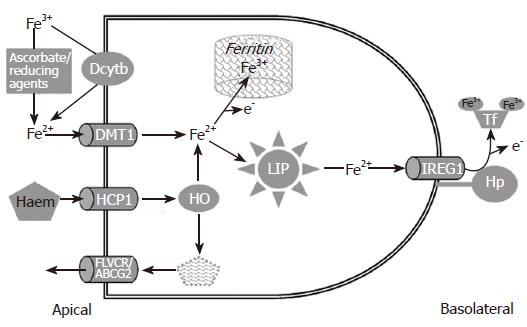Copyright
©2007 Baishideng Publishing Group Co.
World J Gastroenterol. Sep 21, 2007; 13(35): 4716-4724
Published online Sep 21, 2007. doi: 10.3748/wjg.v13.i35.4716
Published online Sep 21, 2007. doi: 10.3748/wjg.v13.i35.4716
Figure 1 The cellular mechanisms involved in intestinal iron absorption.
Dietary non-haem iron (mostly ferric) is reduced by the actions of the ferric reductase Dcytb and reducing agents in the diet to yield Fe2+, which subsequently enters the enterocytes via DMT1. Haem is absorbed via HCP1, broken down by haem oxygenase 1 (HO) to liberate Fe2+ (this joins a common pool with iron from the non-haem pathway) and bilirubin (which might be removed from the cell by the efflux proteins FLVCR and ABCG2). If body iron stores are high, iron may be diverted into ferritin and lost when the cell is shed at the villus tip. Alternatively, iron passes into the labile iron pool (LIP) and is subsequently processed for efflux via IREG1 (as Fe2+). The exiting iron is re-oxidised to Fe3+ through hephaestin (Hp) to enable loading onto transferrin (Tf).
- Citation: Sharp P, Srai SK. Molecular mechanisms involved in intestinal iron absorption. World J Gastroenterol 2007; 13(35): 4716-4724
- URL: https://www.wjgnet.com/1007-9327/full/v13/i35/4716.htm
- DOI: https://dx.doi.org/10.3748/wjg.v13.i35.4716









